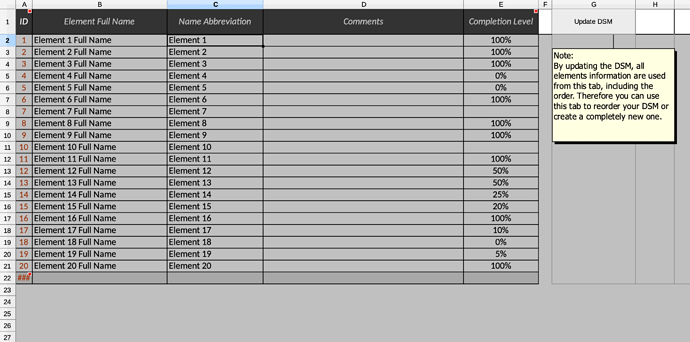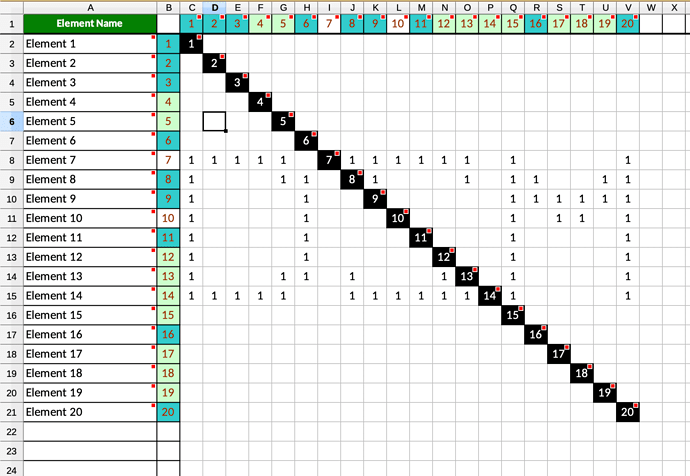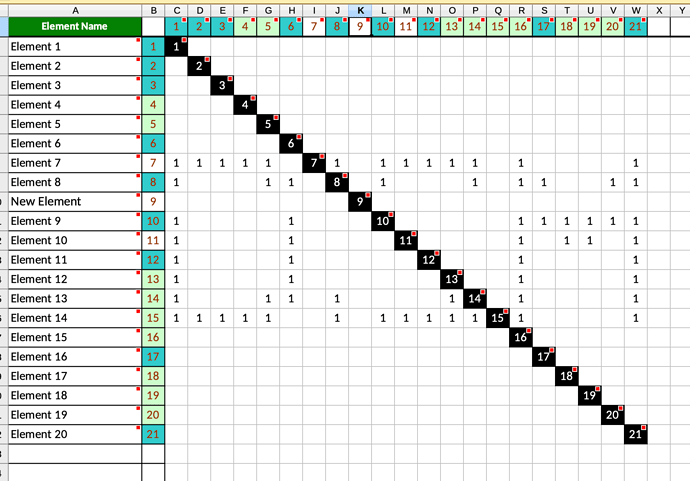Hello I found a Excel tool for creating and updating a DSM matrix(Design structural Matrix) on (Excel Macros for partitioning und Simulation – The Design Structure Matrix (DSM) - Here is the original file be found. I’m not able to add it because the file is to big with 1.3 MB).
Since I use LibreOffice I want to convert it to LibreOffice so I can use it myself. This is my first time I ‘program’ something in Basic. So I run in some troubles.
First a small explanation what the the macro should do in general.
This is the initial situation of the files, both the list and the matrix.
Now I update the list by adding a new item between two existing ones.
If now pressing on the button “Update DSM” the DSM Matrix in Excel it be updated to this:
As you can see the values (‘1’) from Element 9 to Element 20 are shifted a row from element 9 and 1 column from element 9.
This is code that performs some actions in Excel what I’m able to achieve too in LibreOffice.
I put it here for reference
' saving previous DSM interdependency data
Dim oldElementNum As Integer
Worksheets("DSM").Select
oldElementNum = 250
Rem check current highest item number
For i = 1 To 250
If IsEmpty(Cells(i + 1, 2)) = True Then
oldElementNum = i - 1
Exit For
End If
Next i
' create temporary (virtual) DSM matrix
ReDim tmpDSM(oldElementNum + 1, oldElementNum + 1)
' fill temporary DSM matrix with previous filled values
For i = 1 To oldElementNum
For j = 1 To oldElementNum
If (Cells(i + 1, j + 2) = 1) And (i <> j) Then
tmpDSM(i + 1, j + 1) = 1
End If
Next j
Next i
The trouble is in this piece of the macro.
' updating elementNum
elementNum = 250
Worksheets("Elements Info").Select. ' First sheet
For i = 1 To 250
If Cells(i + 1, 1) = 251 Then
elementNum = i - 1
Exit For
ElseIf IsEmpty(Cells(i + 1, 1)) = False Then
tmpDSM(Cells(i + 1, 1) + 1, 1) = i + 1 ' The first row and column of tmpDSM indicate which Excel row and column
tmpDSM(1, Cells(i + 1, 1) + 1) = i + 2 ' correspond to each DSM row and column AFTER the new changes applied
End If
Next I
The ### is the number 251. If the loop sees that this value is found it stop performing the loop.
The part I have difficulties with is the part in the ElseIf.
If the cell is empty (means new row is added) than it shift the values that in the tmpDSM(generated in the reference) to new positions See figure ‘DSM Matrix updated’
This should be converted I guess to something like this:
eish = doc.Sheets.getByName("ElementsInfo")
ReDim tmpDSM(oldElementNum + 1, oldElementNum + 1)
For i = 1 To 250
If eish.getCellByPosition(i + 1, 1).Value = 251 Then
elementNum = i - 1
Exit For
ElseIf eish.getcellByPosition(i + 1, 1).Type = 0 Then
' Shift the existing values from current >= index position a row/ column '
tmpDSM(#Something must happen here#) = i + 1 ' The first row and column of tmpDSM indicate which Excel row and column'
tmpDSM(#Something must happen here#) = i + 2 ' correspond to each DSM row and column AFTER the new changes applied'
End If
Next i
I have the idea it is a kind of virtual cell range but I don’t have a clue how to do this in LibreOffice where everything is related to a cell
Thanks




